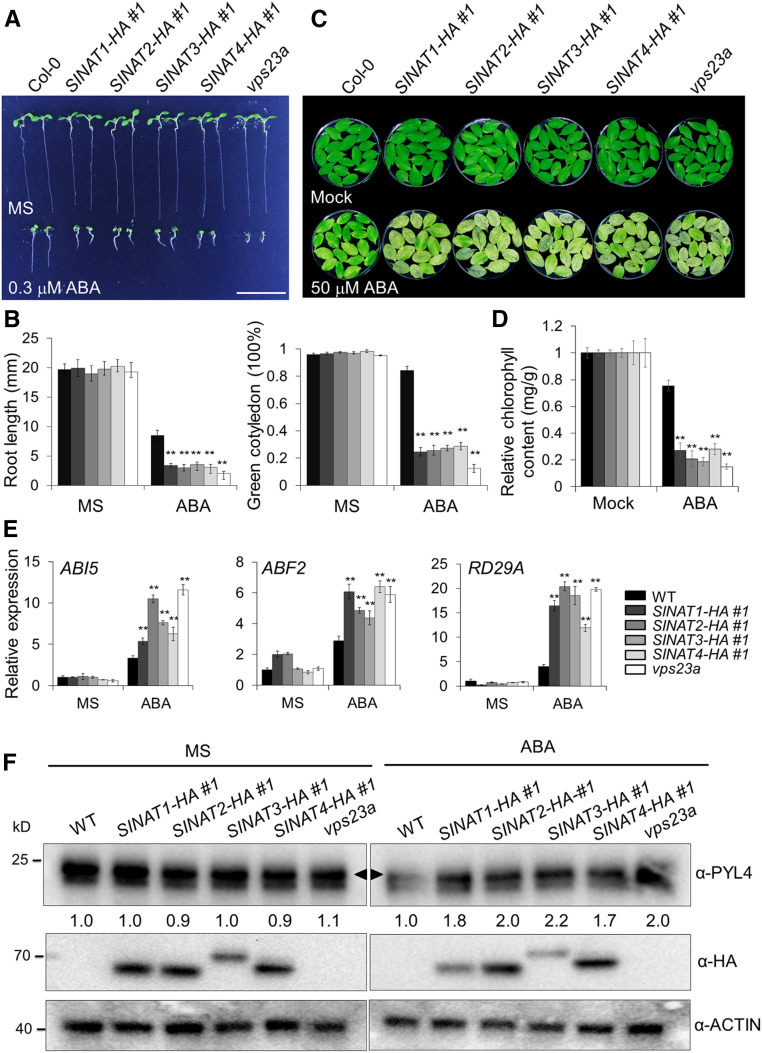Figure 4.
SINAT Overexpression Confers Increased ABA Sensitivity.
(A) Sensitivities of SINAT-overexpression lines to ABA. Seeds of the wild-type (WT) and SINAT-overexpression lines (SINAT1-HA #1, SINAT2-HA #1, SINAT3-HA #1, and SINAT4-HA #1) and vps23a mutant were sown on MS medium with or without 0.3 μM ABA for 7 d. Bar = 10 mm.
(B) Measurements of root length and proportion of green cotyledons in (A). Data are means ± sd (n = 3) of three independent experiments (biological replicates). For each experiment, more than 20 seedlings were measured for root length and more than 100 seedlings were assayed for the green cotyledon frequency. Asterisks indicate significant differences from WT (*P < 0.05; **P < 0.01 by Student’s t test).
(C) Leaf senescence in SINAT-overexpression lines. The detached rosette leaves of the 4-week-old wild type (WT), SINAT-overexpression lines (SINAT1-HA #1, SINAT2-HA #1, SINAT3-HA #1, and SINAT4-HA #1), and vps23a mutant were incubated in distilled water (mock) or 50 µM ABA for 3 d under continuous darkness.
(D) Measurement of chlorophyll contents in (C). The experiments were repeated three times (biological replicates) with similar results, and the representative data from one replicate are shown. Data are means ± sd (n = 3) of three technical replicates. Asterisks indicate significant differences from the wild type (WT; **P < 0.01 by Student’s t test).
(E) RT-qPCR analysis showing ABA-response gene expression in SINAT-overexpression lines. The wild type (WT), SINAT-OE lines (SINAT1-HA #1, SINAT2-HA #1, SINAT3-HA #1, and SINAT4-HA #1), and vps23a (7 d old) grown on MS medium with or without 0.3 μM ABA were harvested for total RNA extraction. Transcript levels of ABI5, ABF2, and RD19A genes in SINAT-overexpression lines relative to the WT were normalized to that of ACTIN2. The experiments were repeated three times (biological replicates) with similar results, and representative data from one replicate are shown. Data are means ± sd (n = 3) of three technical replicates. Asterisks indicate significant differences from the WT (**P < 0.01 by the Student’s t test).
(F) Accumulation of PYL4 protein in SINAT-overexpression seedlings compared with the wild type (WT) under ABA treatment. The 7-d-old seedlings of WT and SINAT-overxpression lines (SINAT1-HA #1, SINAT2-HA #1, SINAT3-HA #1, and SINAT4-HA #1), grown on MS medium with or without 0.3 μM of ABA, were collected for total protein extraction and immunoblot analysis by anti-PYL4, anti-HA, and anti-ACTIN antibodies, respectively. The arrowhead indicates a specific band of PYL4. The relative intensities of PYL4 proteins in SINAT-overexpression lines and vps23a mutant compared with the WT were normalized to that of ACTIN and shown below the anti-PYL4 row. Numbers on the left indicate the molecular weight (kD) of each band.

